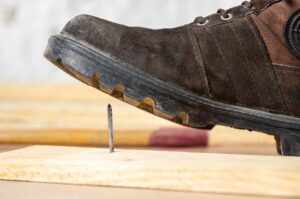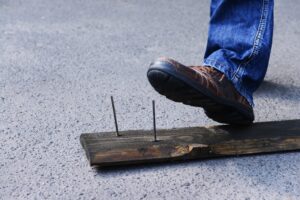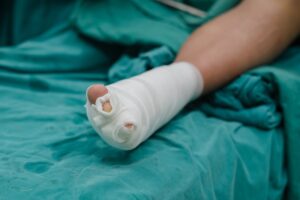By Danielle Graves. Last Updated 8th March 2024. Have you been injured after stepping on a nail at work? If so, you might be entitled to claim. Employers owe their employees a duty of care, and failure to adhere to this, resulting in you being injured, may constitute negligence, and you could be awarded compensation.
Not only will this guide examine how much compensation you might be entitled to, but it will also inform you of the steps that can be taken to strengthen your case’s chance of winning. For example, gathering evidence or hiring a personal injury solicitor.
However, you can speak directly with a member of our team who can offer you a free consultation at a time that is most convenient for you. To get in contact:
- Call us on 0161 696 9685
- Fill out our online enquiry form
- Use the live chat feature at the bottom of your screen
Select A Section
- When Could You Claim For Stepping On a Nail At Work?
- How Could I Step On A Nail At Work?
- Types Of Foot Injuries Caused By Nails
- What To Do After Standing On A Nail
- How Much Could You Receive After Stepping On A Nail At Work?
- Get In Touch To Claim After Stepping On A Nail At Work
When Could You Claim For Stepping On a Nail At Work?
All employers owe their employees a duty of care to take reasonable steps to prevent the risk of injury while at work. This duty of care is set out under the Health and Safety at Work etc. Act 1974.
Reasonable steps your employer could be implementing include:
- Performing regular risk assessments.
- Ensure the workplace is free of clutter and any hazards that can be removed.
- Providing you with appropriate personal protective (PPE), such as safety boots.
If you stepped on a nail at work and injured yourself, you may be eligible to make a personal injury claim. For your case to be valid, you will need to prove the following:
- A duty of care was owed by your employer.
- They breached their duty of care.
- This caused you to suffer your injury.
To discuss your potential accident at work claim today and receive free advice, you can contact our team of advisors. They can also help answer questions you may have about the claiming process.
What Is The Accident At Work Claim Time Limit?
In addition to meeting the eligibility requirements, you must start legal proceedings within the relevant accident at work claim time limit. This is generally three years from the date that you were injured when you stepped on a nail at work.
However, there are certain expectations to this three-year time limit. This includes:
- Those lacking the mental capacity to make a claim for themselves will have an indefinite suspension applied to the limitation period. Should they regain this capacity, they will have three years from the recovery date to start the process if a claim hasn’t already been made for them.
- Those under the age of 18 who suffered an injury in a workplace accident. For these cases, the claimant is unable to start the claiming process until they turn 18. If a claim has not been made by the date of their 18th birthday, they will have three years to start one.
A litigation friend could begin the claiming process on the injured party’s behalf while the time limit is suspended.
Contact our advisors today to see whether you could make a personal injury claim if you suffered a foot injury at work. If you are eligible, they could also inform you whether you have enough time to start your claim.
How Could I Step On A Nail At Work?
There are a number of ways that you could be injured by employer negligence, which may entitle you to make a claim. For example:
- Your employer might not have provided you with the necessary puncture-proof footwear when working in a warehouse. Consequently, you suffer an injury after stepping on a nail at work.
- An employee without the proper training may be tasked with using a nail gun to complete a task in the office. As a result, nails are left on the floor and you step on one, leading to you enduring a laceration.
- You are walking down a stairwell with no lighting in a factory. Because of this, you step on a nail that you cannot see. This causes you to fall down the stairs and sustain a foot injury as well as a head injury and elbow injury in the ensuing factory accident.
If you have been injured at work due to employer negligence, you might be able to claim. Speak with our advisors for more details.
Types Of Foot Injuries Caused By Nails
Stepping on a nail at work could lead to multiple injuries. For instance:
- A puncture wound. The width and depth of this could depend on the size of the nail.
- Torn skin or lacerations
- An infection in the injured area. For example, if the nail is dirty or the wound is left untreated, this could lead to issues such as sepsis, cellulitis, and osteomyelitis
- Tetanus
The severity of these injuries can vary with each case which is why it may be important to seek compensation. For example, if the nail is dirty or the wound is left untreated, this could lead to issues such as sepsis, cellulitis, and osteomyelitis.
Furthermore, a puncture wound from standing on a sharp object could damage the nerves, ligaments or tendons of the foot. This could inhibit mobility while the injury heals. In some cases, it could cause permanent repercussions.
Please do not hesitate to get in touch with an advisor from our team for more information in terms of how stepping on a nail could impact you.
What To Do After Standing On A Nail
If you suffer a puncture wound after stepping on a nail at work, you could be eligible to make a personal injury claim. However, any compensation claim needs to have supporting evidence.
Any action you took to treat puncture wounds following the incident could have generated useful evidence. For example, following puncture wounds and a foot injury, you may have:
- Decided to seek prompt medical care. For example, after stepping on a rusty nail, you may require a tetanus vaccination or tetanus booster. If you sought medical attention for your puncture wounds, your visit to a GP or hospital for medical help would have created a note in your medical records about the incident. A copy of these can be submitted when claiming compensation.
- Filled in the accident book. Any workplace that employs ten or more members of staff is required to have an accident log book. This should be filled out with your personal details, the time and date and any details relating to your accident. A copy of the accident log book can be submitted in support of a personal injury claim.
- Taken photographs. You may have taken pictures of the rusty nails that caused your injury or of the injury itself while it healed. Any photographs you took relating to your accident at work can be used to support a claim for compensation.
- Noted witness contact information. If anyone saw the incident that caused your nail puncture, you may have taken their contact details. Witnesses can provide a statement further into the claims process.
If you need any free advice about obtaining evidence, speak with a member of our advisory team.
How Much Could You Receive For Stepping On A Nail At Work?
If you are successful in your claim, the personal injury compensation you could be awarded may be split into two areas. All successful personal injury claims will include compensation for the pain and suffering caused by your injures; this is called general damages and accounts for both physical and mental injuries.
We have drafted a table of compensation figures that have been taken from the Judicial College Guidelines (JCG) which is a document of guideline brackets that lawyers use to help them value claims. We’ve also included the top entry, which isn’t from the JCG, but shows how compensation could be awarded in successful work claims. However, these amounts should only be used as guidance. This is because each accident at work claim is unique, and these figures are not guaranteed.
| Body Part | Severity | Compensation Bracket | Details |
|---|---|---|---|
| Multiple serious injuries and expenses | Very Serious | Up to £250,000+ | Settlements could include compensation for more than one severe injury plus any incurred expenses such as lost of wages and wheelchair purchase. |
| Foot | Amputation of one foot | £83,960 to £109,650 | Considered similarly to a below-knee amputation as the useful ankle joint is lost. |
| Foot | Very Severe | £83,960 to £109,650 | Injuries found in this bracket produce permanent severe pain or a really serious disability that is permanent. |
| Foot | Serious | £24,990 to £39,200 | These injuries cause continuing pain from traumatic arthritis or the risk of arthritis in the future. The treatment is prolonged and there's a risk of fusion surgery. |
| Foot | Moderate | £13,740 to £24,990 | Involves continuing symptoms with the risk of osteoarthritis and future surgery. |
| Foot | Modest | Up to £13,740 | Puncture wounds and the like which cause permanent symptoms, such as pain aching or a limp. |
| Toe | Amputation | In the region of £31,310 | Amputation of the big toe. |
| Toe | Severe | £13,740 to £21,070 | Bursting wound injuries that lead to considerable permanent symptoms. |
| Toe | Serious | £9,600 to £13,740 | There will be some permanent disability by way of discomfort, pain, or sensitive scarring. |
Moreover, you might be awarded special damages for the monetary harm that you’ve incurred as a result of your injuries. For instance, you might be unable to drive until your foot recovers. Any travel costs, such as taxis, may be reimbursed through special damages.
It could also account for:
- Loss of earnings
- Home adaptations
- Care costs
- Medical expenses
Please speak with an advisor if you would like a more personalised insight into how much compensation you may be awarded in a successful claim. If your case is valid, you could be connected with a lawyer from our panel.
Get In Touch To Claim After Stepping On A Nail At Work
A personal injury solicitor from our panel can use their vast experience to cover all bases of your claim after stepping on a nail at work. This could help make the process run more smoothly than if you worked on your claim alone.
Claimants may find it beneficial to seek representation with a No Win No Fee agreement in place. The solicitors on our panel offer their services under a Conditional Fee Agreement (CFA).
If you are represented on this basis, there are generally no fees to be paid to your lawyer upfront or while your claim is ongoing. Moreover, if your claim is lost, you typically won’t have to pay any fees for the services your solicitor provides.
However, in the event of a successful claim, you will have to pay a legally capped success fee to your solicitor. This will be deducted from the payout you receive.
An advisor from our team is available to provide you with free legal advice 24 hours a day, 7 days a week. They may also connect you with an accident at work solicitor from our panel. To get in touch:
- Call us on 0161 696 9685
- Fill out our online enquiry form
- Use the live chat feature at the bottom of your screen
Learn More About Protecting Your Feet At Work
Here are some more of our guides that can be useful when considering making an accident at work claim:
- I got hurt at work. Do I need a lawyer?
- Why is it important to report accidents in the workplace?
- I was stuck in a lift. Could I claim compensation?
- This guide can help you understand what to do after you’ve had an accident in a restaurant.
Furthermore, we have included additional reading that may be useful for you:
- NHS – Cuts and grazes
- GOV – Statutory Sick Pay (SSP)
- Health and Safety Executive – Employer’s responsibilities
Thank you for reading this guide on how to claim if you have been injured after stepping on a nail at work.






